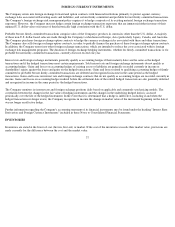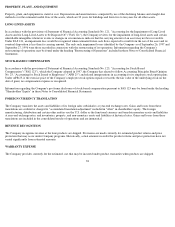Apple 1997 Annual Report Download - page 39
Download and view the complete annual report
Please find page 39 of the 1997 Apple annual report below. You can navigate through the pages in the report by either clicking on the pages listed below, or by using the keyword search tool below to find specific information within the annual report.be sufficient to utilize the tax carryforwards prior to their expiration in 2011 and 2012 to fully recover the asset. However, there can be no
assurance that the Company will meet its expectations of future U.S. income. As a result, the amount of the deferred tax assets considered
realizable could be reduced in the near and long term if estimates of future taxable U.S. income are reduced. Such an occurrence could
materially adversely affect the Company's consolidated results of operations and financial condition. The Company will continue to evaluate
the realizability of the deferred tax assets quarterly by assessing the need for and amount of a valuation allowance.
SUMMARY OF SIGNIFICANT ACCOUNTING POLICIES
FINANCIAL INSTRUMENTS
INVESTMENTS
All highly liquid investments with a maturity of three months or less at the date of purchase are considered to be cash equivalents; investments
with maturities between three and twelve months are considered to be short-term investments. As of September 26, 1997 there are no
investments with maturities greater than twelve months. The Company's U.S. corporate securities include commercial paper and corporate debt
securities. Foreign securities include foreign commercial paper, loan participation and certificates of deposit with foreign institutions, most of
which are denominated in U.S. dollars. The Company's cash equivalents and short-term investments are generally held until maturity.
Management determines the appropriate classification of its investments in debt and marketable equity securities at the time of purchase and
reevaluates such designation as of each balance sheet date. The Company's debt and marketable equity securities have been classified and
accounted for as available-for-sale. These securities are carried at fair value, with the unrealized gains and losses reported as a component of
shareholders' equity. These unrealized gains or losses include any unrealized losses and gains on interest rate contracts accounted for as hedges
against the available-for-sale securities. The cost of securities sold is based upon the specific identification method.
FINANCIAL INSTRUMENTS WITH OFF-BALANCE-SHEET RISK
In the ordinary course of business and as part of the Company's asset and liability management, the Company enters into various types of
transactions that involve contracts and financial instruments with off-balance-sheet risk. These instruments are entered into in order to manage
financial market risk, primarily interest rate and foreign exchange risk. The Company enters into these financial instruments with major
international financial institutions utilizing over-the-counter as opposed to exchange traded instruments. The Company does not hold or
transact in financial instruments for purposes other than risk management.
INTEREST RATE DERIVATIVES
The Company enters into interest rate derivative transactions, including interest rate swaps, collars, and floors, with financial institutions in
order to better match the Company's floating-rate interest income on its cash equivalents and short-term investments with its fixed-rate interest
expense on its long-term debt, and/or to diversify a portion of the Company's exposure away from fluctuations in short-term U.S. interest rates.
The Company may also enter into interest rate contracts that are intended to reduce the cost of the interest rate risk management program.
In addition, the Company has entered into foreign exchange forward contracts to hedge certain intercompany loan transactions. These forward
contracts effectively change certain foreign currency denominated debt into U.S. dollar denominated debt, which better matches against the
Company's U.S. dollar denominated cash equivalents and short-term investments. No such contracts existed as of September 26, 1997.
36
























